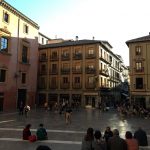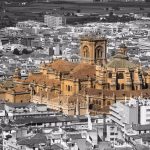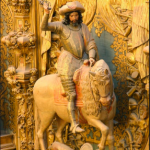- Facade of the Cathedral
- Plaza de las Pasiegas
- View of the Cathedral from the Alhambra
I was amazed to learn that the Cathedral of Granada is the second largest cathedral in Spain (after, of course, the Cathedral of Sevilla) and also the first Renaissance cathedral in Spain. The whole interior of the cathedral is filled with luminous marble arches, and light streams in from all around; it is so much more open and spacious than any other cathedral I have been in. While the Cathedral and Royal Chapel are connected to each other, they are actually built in different architectural styles (the Cathedral in Spanish Renaissance, the Chapel in the Spanish Gothic style known as Isabelline). The reason for this is significant: after the conquest of Granada, a makeshift cathedral was built on the location of Granada’s Great Mosque (very similar to what occurred with the Mezquita in Córdoba). After the Royal Chapel was completed, the mosque-cathedral was actually torn down and rebuilt (over a period of 181 years, from 1523-1704) in the new styles of the time, Renaissance with a touch of Baroque.
- The dome of the Main Chapel
- The Chapel is filled with stained glass and a series of paintings that depict the life of the Virgin Mary.
- Interior of the Cathedral
The Cathedral is undeniably beautiful, yet one thing that stood out to me amidst all its beauty was the Triunfo de Santiago, a huge wooden carving of Santiago Matamoros (St. James the Moor-slayer), complete with a dead Moor trampled underfoot. Even though I had been expecting to encounter the image of Santiago Matamoros somewhere in Spain, I was nonetheless shocked by such a brutal image in such a holy place. In both the Cathedral and Chapel it was hard to escape from images and reminders of the Christians’ conquest over the Muslims.
- Triunfo de Santiago
The Royal Chapel houses the remains of Isabella of Castille and Ferdinand of Aragon—the so-called Catholic Monarchs who united the kingdoms of Iberia into a unified Christian Spain, instituted the Inquisition, and funded Columbus’s voyage to the ‘New World.’ Isabella and Ferdinand were a constant presence throughout our trip, and so seeing their tombs was a remarkable experience. The monarchs had originally planned to be buried in Toledo, but after their conquest of Granada in 1492, they changed their mind, viewing the conquest as the crowning achievement of their reign. The grand marble tombs of Isabella and Ferdinand, along with the tombs of their daughter Joanna (Juana la Loca) and her husband Philip I (Felipe el Hermoso) are raised high above the ground and face a magnificent gold altarpiece, symbolic of their close relationship with God.
- Exterior of the Royal Chapel
- Tombs of Ferdinand and Isabella
- Coffins of Isabella and Ferdinand in the crypt
This altarpiece is comprised of 34 carved panels depicting religious and historical scenes; significantly, the bottom four depict Boabdil, the last Nasrid king of Granada, surrendering the key to the city in 1492, and the baptisms (i.e., forced conversions) in 1500 of Granada’s Muslim men and women. This is not the only depiction of these events, as in the entrance hangs a copy of Francisco Pradilla’s painting, the Surrender of Granada. These images serve as a reminder of how connected the territorial and political unity of Spain were with Isabella and Ferdinand’s achievement of religious unity throughout the peninsula.
- Interior of the Royal Chapel
- Altarpiece of the Cathedral
- Francisco Pradilla’s Surrender of Granada
- The Sacristy museum of the Royal Chapel houses Isabella’s crown and sceptre, as well as her missal, mirror, and personal art collection (which contains Flemish, Italian (including Boticelli), and Spanish works.)
- Isabella’s crown and sceptre, and Ferdinand’s sword
- Isabella’s jewelry box
The audioguide we listened to emphasized repeatedly the importance of the conquest of Granada, exalting Isabella and Ferdinand as national heroes who united the kingdoms of Spain, recovered Spain’s territory that had been lost during the Middle Ages, and, through funding Columbus’s discovery of the New World, laid the groundwork for a world-wide expansion of Spanish culture and initiated the Modern Era of history. Isabella’s piety as a leader of Catholicism during her reign is also emphasized repeatedly, yet jarringly absent from the official audioguide’s tour was any mention of the Inquisition, the expulsion of the Jews, or the forced conversion of the Muslims. There is no doubt that this chapel holds immense historical, artistic, and religious value; Isabella and Ferdinand are perhaps the most important monarchs of Spain, whose reign created lasting impacts into the modern world and whose unification of Spain and funding of Columbus are learned about by students around the world, and for this reason the Royal Chapel is naturally an important and reverenced site. Yet at the same time, it is easy to gloss over the darker side of their reign, which effectively ended the uniquely Andalusian culture of religious tolerance, and initiated centuries-long religious persecutions. While I think that the Royal Chapel is justified in many ways for celebrating Spain’s Catholic Monarchs, at the same time, I think important historical and tourist sites like this have a duty to present to visitors all sides of the history and historical figures that these sites preserve and commemorate.

























Thanks for a marvelous posting! I certainly enjoyed reading
it, you could be a great author. I will make sure to bookmark your blog
and will eventually come back later in life.
I want to encourage continue your great work, have a nice holiday weekend!